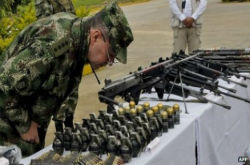Reported seizures of firearms in Colombia and Mexico far outstrip those of war-torn Iraq, according to a new United Nations report, a reflection of the huge demand for illicit weapons among organized crime syndicates in Latin America.
The most recent United Nations Office on Drugs and Crime (UNODC) Study on Firearms (pdf) found that out of the 39 UN member states surveyed, Colombian and Mexican police seized the greatest number of weapons between 2010 to 2013.
Colombia confiscated an average of 39,925 firearms per year, while Mexican authorities averaged seizing 28,885 guns annually over the four-year span (see graph below). Both Brazil and Iraq seized an average of over 13,000 weapons per year, although the Middle Eastern country did not supply data for 2013.
Colombia also had the highest number of seizures per capita (84.3 per 100,000) among the surveyed countries that recorded data for all four years, while Panama ranked third (57.6 per 100,000). In 2012, El Salvador recorded the highest rate of seizures of any country in a single year (122.7 per 100,000). (See graph below for weapon seizures based on population for all surveyed countries in Latin America and the Caribbean.)
The UNODC also looked at where the seized weapons were produced. The United States manufactured 20 percent of the firearms confiscated in Guatemala during the four-year span, slightly lower than the percentage of seized weapons made in Israel (23.8 percent) and Argentina (23.8 percent). The United States produced less than 10 percent of all weapons seized in the other Latin American nations (Brazil, Ecuador, Uruguay) that traced seized firearms to the country that manufactured them.
The study also notes the large fluctuations in reported seizures from one year to the next. For example, Mexican authorities reported confiscating 40,996 firearms in 2011 but just 25,803 weapons in 2012, a 59 percent drop-off from the previous year. Reported seizures in Ecuador jumped 796 percent from 2010 to 2011.
The UNODC found a correlation between seized weapons and organized crime activity among the UN member states surveyed, which suggests “the illicit acquisition of firearms is largely linked to criminal groups, rather than being widespread in the general population,” the report states.
InSight Crime Analysis
That Colombia and Mexico seized more than twice the number of firearms as war-torn Iraq highlights the extent to which criminal organizations generate demand for illegal weapons. The presence of organized criminal groups within a country can cause the black market for weapons to expand in several ways. At a most basic level, they need to arm their members in order to protect drug shipments and facilitate other illicit activities. Criminal groups are also creating greater demand for weapons by contracting smaller, local gangs to serve as “sicarios” (hired killers) and perform other criminal acts on their behalf.
This criminal outsourcing could be driving up the illegal weapon trade in other parts of the region as well. As Mexican criminal groups have begun moving their operations to other parts of Latin America in an attempt to seize control further down the drug supply chain, they have reportedly begun arming local gangs with AK-47s and grenades in countries like Costa Rica.
SEE ALSO: Mexico News and Profiles
The fragmentation of monolithic drug trafficking organizations that once dominated the underworlds in Mexico and Colombia could also be fueling the demand for illegal weapons. The emergence of splinter cells and new criminal groups in Mexico are frequently engaged in battles for previously undisputed drug routes and territories. Although Colombia’s underworld is currently witnessing a “pax mafioso,” the country remains entrenched in a long-standing armed conflict with left-wing guerrilla groups.
Where are the Illegal Weapons Coming From?
The large number of seizures in Mexico suggests customs agents on both sides of the border are struggling to stem the flow of illegal weapons being smuggled from the United States into Mexico. The UNODC did not provide data on the percentage of US-made firearms that were confiscated in Mexico. However, the US Bureau of Alcohol, Tobacco, Firearms and Explosives (ATF) found 53.3 percent of all seized firearms submitted by Mexican authorities in 2014 for tracing were manufactured in the United States.
But the significant variations in seizure data — and the small sample size of the UNODC report — means we should be cautious about pointing to larger trends in the region’s arms trade, a criminal industry that is still poorly understood. “Especially in Latin America and the Caribbean, I would say research is still very much in its infancy,” Nic Marsh, a researcher at the International Peace Research Institute and co-author of the UNODC study, told InSight Crime.
SEE ALSO: Coverage of Arms Trafficking
With this limited data set, it is difficult to determine if the peaks and valleys in weapon seizures are the result of changes in demand, or the result of improved interdiction efforts by authorities. According to Marsh, this lack of information on seizures over a long time period hinders lawmakers’ ability to come up with better policy solutions. “You need to have an idea of those trends if you’re going to have an idea about whether the policies, laws, and regulations are working,” he said.

